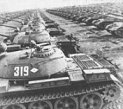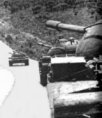

Cuban Tanks, II partRuben Urribarres |
These heavy tanks named as the soviet leader (IS- Iosif Stalin), and were produced during the Second World War.
The IS-2M begin to arrive to Cuba at the end of 1960 year. For April of 1961 already were two IS-2M Regiments, with 41 tanks, final figure. During Bay of Pigs they were maintained as reserve by Fidel Castro, near the sugar factory Australia, and not they fight.
Although some times the exilian forces claim to see it, but in reality they confuse them
with the SU-100. The IS-2M are maintained today in the same situation that the
T-34-85.
| Built:
1944 Dimensions: lengh 9830 mm, height 2730 mm, width 3070 mm Armor: turre 90-160, hull 20-120 mm Armament: One 122 mm gun D-25T, three 7,62 mm machine guns DT, and one 12,7 mm DShK | Crew:
4 Weight: 46 t Speed: 37 km/h Road radius: 240 km |
 | Heavy Tank IS-2 similar to the 41 exemplary delivered to Cuba |
When Fidel Castro were in visit to the USSR in may 1963, he ask for 120 T-55 of these excellent tanks, but Jrushov changes the asked to T-34-85. But Jrushov fears to get worse more the relations with US after the Missile Crisis, and changes the asked to 80 T-34-85.
However, in
the same 1963 year, the soviet troops in Cuba during Missile Crisis receive the
order of left their heavy armament to the Cubans, free of pay, and to training
them in them. Among them were the T-55 of two Soviets Tanks Battalions.
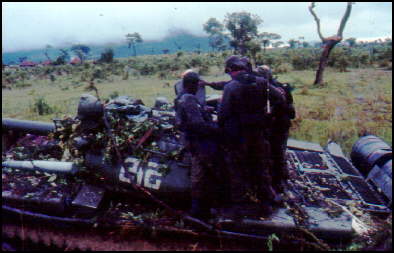 Cubans soldiers over a T-55 in Angola
Cubans soldiers over a T-55 in Angola
In 1976 the T-55 were send to Angola together the T-34-85, where they defeat
the combined forces of South Africa and their allies. The Angolan war was revived
in the 80´s with the Reagan administration. In 1987 South Africa begin an
extensive intervention in Angola. On September were the first Tanks combats in
this War, between the Angolans T-55 and the Olifants.
After defeating the angolans by the Lomba River, its troops advance toward Cuito
Cuanavale. Angola asks aid to the Cuban command, that sends advisors and some
units to defend Cuito Cuanavale. February 14, 1988 the SADF and the UNITA begin
a heavy attack to the Cuito Cuanavale defenses, supported by 100 armored of various
types, among them 40 Olifants Tanks, and by this superiority of forces, they achieve
to break the defense of the 59° Angolan Brigade. To cover this place were
urgently thrown the unique 8 T-55 Cubans in movement in Cuito, by the command
of the lieutenant colonel Héctor Aguilar. They stop the South African,
destroying 10 Olifants and 4 armored cars, and losing 6 T-55 (3 by anti-tanks
rockets RPG, and 3 by the Olifants). The remainder of the Olifants retires behind
march. In this collision die 14 of the 39 Cubans perished in the battle of Cuito
Cuanavale, but this sacrifice went not in vain, therefore the attack of its T-55
saves the situation of the battle, that already was in crisis. This is the first
collision in the war between Olifants and Cubans T-55, and is a victory for these,
which would be the norm until the end of the war. Then comes the subsequent Cuban
offensive toward the Namibian border, pursuing the defeated forces of the South
African SADF, after which in June 27, 1988 South Africa asks for peace to Cuba.
In this campaign the Cubans T-55 Cubans carried the main weight of the ground
war.
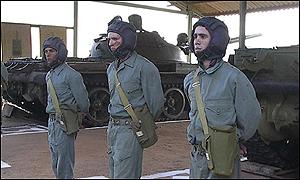 |
(Photos BBC) |
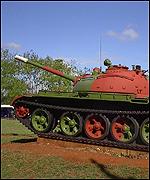 |
In 1977 Somalia invades the ethiopian territory of Ogaden, and
the government of Ethiopia asks for military aid to Cuba. At the end of
December 1977 arrive the first T-55, and on February of 1978 several Cuban Tank
Brigades with T-55 enter in combat against its somalis homologous. Somalia
by irony of the destiny, had also been equipped with 250 T-55 and trained by the
Russians. The Cuban armored forces, of equal number but much better prepared,
defeat in various fierces battles to the enemy, contributing decisively to their
out from the ethiopian territory. Somalia never could be recuperated. Today are
some 1,100 T-55 in service in Cuba, great part in conservation. Part of the T-55
are modernized according to Russian programs, with complementary armor, laser
equipment, new fire control systems
| Built: 1955 Dimensions: lenght 9000 mm, heidth 2218 mm, width 3270 mm Armor: turret 160 mm, hull 100 mm Armament: One 100mm D-10T2S gun, two 7,62 mm machine guns SGMT | Crew:
4 man Weight: 36,500 kg Speed: 50 km/h Road radius: 480 km |
![]() T-62 Main Battle Tank
T-62 Main Battle Tank
Is the
best Tank in Latin America. The T-62 arrive at Cuba since 1976 until the USSR
disappear. In 1988 they were send to Angola to figth the South African
escalation in the war, being the most powerful tank of the conflict. In combats
after the victory in the Cuito Cuanavale battle
in 1988, they contribute to stop and defeat the South African armor forces with
Olifants Tanks, that was an inferior Tank an all aspects, in compare to
the T-62. Then they participate began the victorious offensive to the Namibian
border, after which Sudafrica asks for the peace. Today are near 400 T-62 in Cuba,
part of which are in conservation, and they are modernized of the same form that
the T-55 described up.
| Built: 1960 Dimensions: lenght 9335 mm, height 2395 mm, width 3300 mm Armor: turret 153-242 mm, hull 46-100 mm Armament: One 115 mm gun 2A20, one 7,62 mm machine gun SGMT | Crew:
4 man Weight: 37,500 kg Speed: 50 km/h Road radius: 450 km |
 |
 |
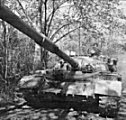 |
| |
|
|
![]() PT-76 Amphibious Tank
PT-76 Amphibious Tank
These
amphibious tanks begin to arrive at Cuba in the 70's. A total of 60 serve in the
Marines.
| Built:
1951 Dimensions: lenght 7,635 mm; height 2,195 mm; width 3,140 mm Armor: turret 10-20 mm, hull 10-13 mm Armament: One 76 mm gun D-56T, one 7,62 mm machine gun SGMT | Crew: 3 man Weigh: 14 t Speed: 10,2 en agua Road radius: 250 km |
 | A Cuban PT-76 comes out the waters, in maneuvers. After a demonstration before the Soviet Leader Jrushov similar to this, this tank was adopted for the USSR |
|
|
|
|
|||

